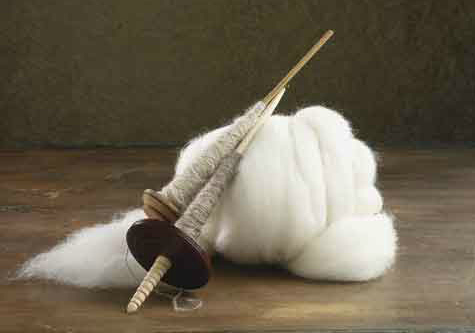I’m not one of those admirable souls who plans ahead. And while I sometimes conceive of a handspun, handwoven project and go from there, more often, I proceed in an impetuous, feely way.
This usually begins when I’m exposed to a lot of great fiber. I don’t think ahead at all; I just swoon and buy. Turn me loose in the market at SOAR or Rhinebeck or any weaving conference or local shop, and I fall in love at first sight—over and over. I go for small quantities for the obvious reason: what am I going to do with it? Unless it’s an unusually yummy fleece, of which I have a few.
In this manner, I have amassed a significant stash. I run my hands through it from time to time in a Scrooge McDuck fashion, loving the feel, the sheen, the squeezability. When I have a bit of time to spin, I pull out whatever speaks to me at the moment and spin it however it seems to want to be spun.
I do have general preferences. I like fine, fairly regular yarns. Not just because that’s the easiest kind to spin, but because they lend themselves best to weaving wearable fabrics. And while knitters savor the time they get to fondle their handspun while they are knitting, I plan to savor the feel of my handspun in the silk scarf around my neck or the woolly little blanket on my lap.
So I take the fiber that calls out to me at the moment, spin it willy-nilly for the pleasure of the process, and hang it up where I can look at it. Now, I’m not one of those spinners who makes yarn skeins as ends in themselves; I really do want to use my handspun. My collection of skeins gathers there on a hanging rod, and I look at them daily. Then, when I have the time and temperament to do some weaving, I visit my yarn just as I would visit my local yarn shop. That is, I see a yarn that quite catches my fancy—or maybe three or four yarns together that sing in harmony—and I think, “What can I make out of that?” Only then do I go into analytical mode and figure how much yarn I have, what sett it requires, what weave structure would show it off well, how long to measure my warp, and so on.
This is backward, I know. I so admire spinner-weavers who take the opposite approach. But I’ve gotten a lot of casual pleasure from making yarn and cloth this way. However you think about spinning and weaving, here are some basics that I find useful:
One Weaver's Approach to Spinning
- You can weave on a handspun singles warp. This is good to know if you are spinning a variably dyed fiber and want clear color effects in the warp. It’s no big trick—just avoid lumps that will catch or skimpy areas that will drift apart.
- Check your handspun warp for strength by tugging gently on a bundle of ends, not just one. If your warp has good, even tension, the strength of the whole will be much greater than its parts. You might be surprised at how easy it is to spin a good handspun warp.
- If you’re truly nervous about warp breakage, use a warp sizing. This can be as simple as mixing a packet of nonfat dried milk power and two cups of water, or two tablespoons of unflavored gelatin in two cups water (as for making jello), immersing your warp chain in it, and wringing it out and drying it well before dressing the loom. This will make the fibers cling together and not abrade against each other, the heddles, or the reed. (Voice of experience: If you live in a humid climate, the milk sizing could get a little stinky before you’ve finished weaving. . .)
- You don’t need to spin a ton of yarn to achieve an effective piece of cloth. Throw in stripes or even single ends of your most gorgeous handspun against a plain warp or weft. Be inventive. That’s a great part of the fun.
Weaving with handspun holds many of the same pleasures for me as cooking from scratch. It would be most unusual to think, in April, that I will want a gazpacho in July so I’d better get those tomatoes, cucumbers, peppers, and whatnot in the ground. Instead, I love going out into the garden and inventing a meal from what I find. Weaving from scratch is even better, though, because the end product has a long life of its own.
—Linda


